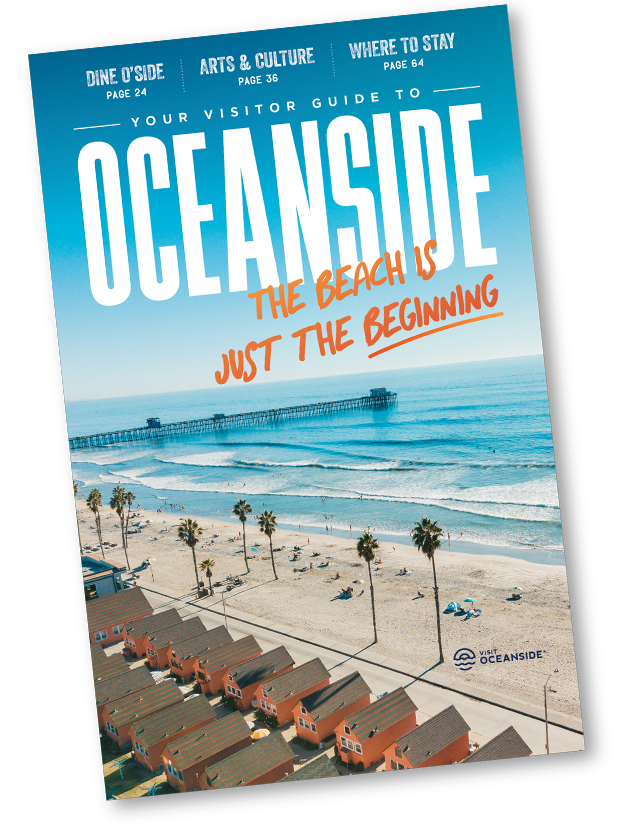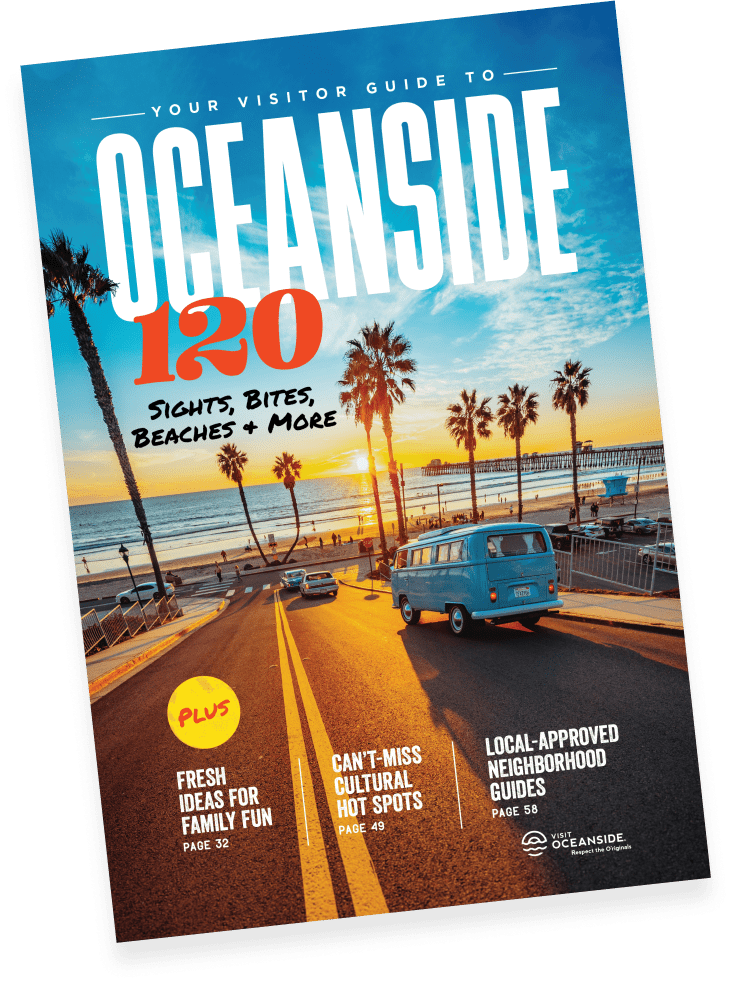By Kristi Hawthorne, O’sider and Director of the Oceanside Historical Society.
Oceanside – the name says it all. Just the name inspires and conjures thoughts of ocean views, sandy beaches and a life of leisure. As early as September of 1883, just a few months after a townsite was laid out, Andrew Jackson Myers, the city’s founder began marketing the town as a seaside resort. He arranged excursions from San Bernardino and the San Diego Union reported that the train bringing visitors from inland to our coast consisted of thirteen cars and about 760 passengers.
The following year in 1884 the San Bernardino Index reported that Oceanside would soon become “a favorite resort of sea-side pleasure seekers of this county.” A large wooden stairway was built from the bluff providing access to the beach and another newspaper reported that, “People have commenced to arrive at Oceanside for summer bathing. G.W. Graves and family and others are now there enjoying themselves in surf-bathing and fishing.”
Many of Oceanside’ first investors, and those purchasing ocean view lots came from Riverside, Redlands and San Bernardino. Another San Bernardino paper reported in 1885: “A number of our citizens while at Oceanside yesterday made arrangements to purchase lots there to build summer cottages. Oceanside will be our summer resort, and one of the most pleasant we know of, with its long stretch of beautiful beach, its convenience to San Bernardino and San Diego, its favorable climate and many other advantages.”
In 1886 the Los Angeles Express referred to Oceanside as a “charming seaside resort” and went on to describe the city as “combining a magnificent beach, high and level ground for a town site, magnificent climate and charming scenery. The beach is unsurpassed, being smooth, hard and level as a floor, making a delightful boulevard over which buggies and other vehicles can be driven for twenty miles in either direction.”
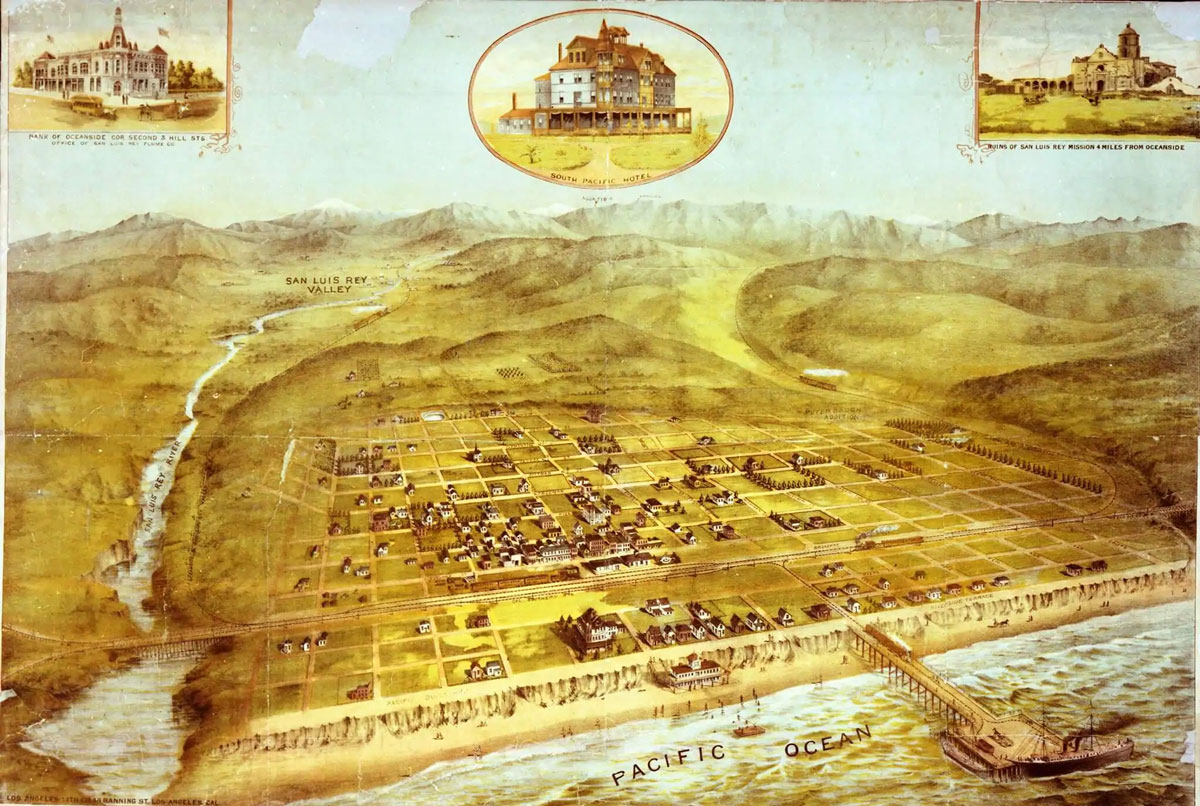
1887 Lithograph of Oceanside
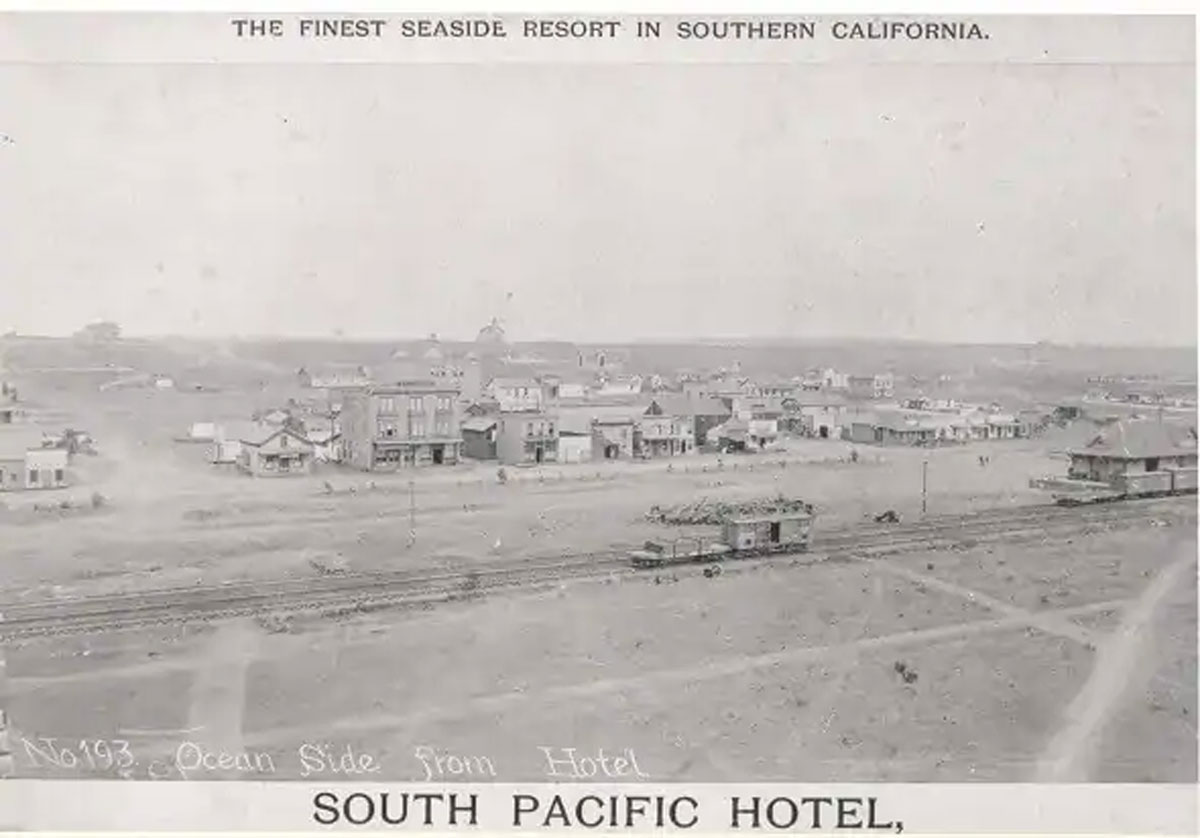
South Pacific Hotel postcard touting Oceanside as “The Finest Seaside Resort in Southern California.” (c.1890)
History of Tourism and Entertainment
In 1887 a beautiful colorized lithograph of an “aerial view” of Oceanside was sent all over the country advertising the town’s assets. In W.D. Frazee’s book “Oceanside” published in 1888, a doctor’s testimony stated reasons why Oceanside was good location for a health resort: “The invalid finds health and bright spirits, the pleasure seeker finds variety and amusement.”
By 1888 Oceanside boasted of several hotels, including the beautiful South Pacific Hotel, a wharf, an opera house and a bathhouse. These amenities were advertised in newspapers in Southern California and as far away as San Francisco and nearby states.
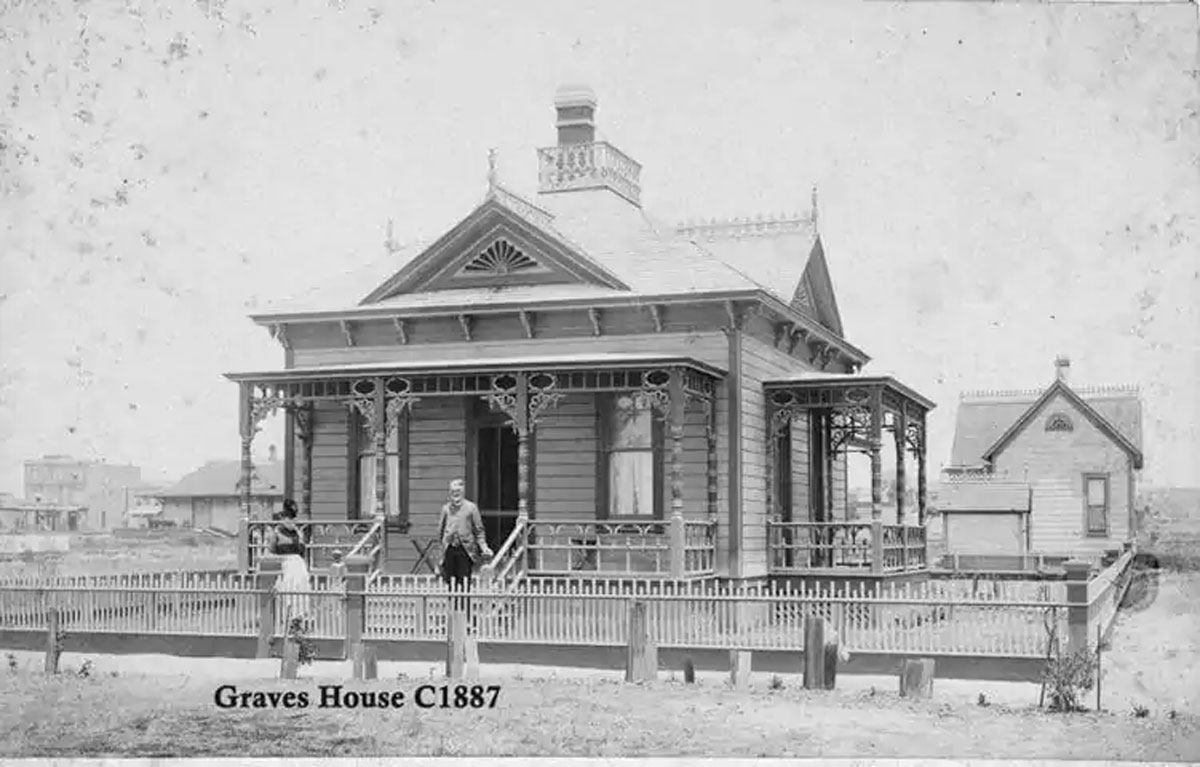
Graves House (1887) Summer home of Doctor Graves. Could be considered the first vacation rental. More famously known as the Top Gun House from the 1986 movie. Can now be seen fully restored at the Mission Pacific Hotel on Pacific St.
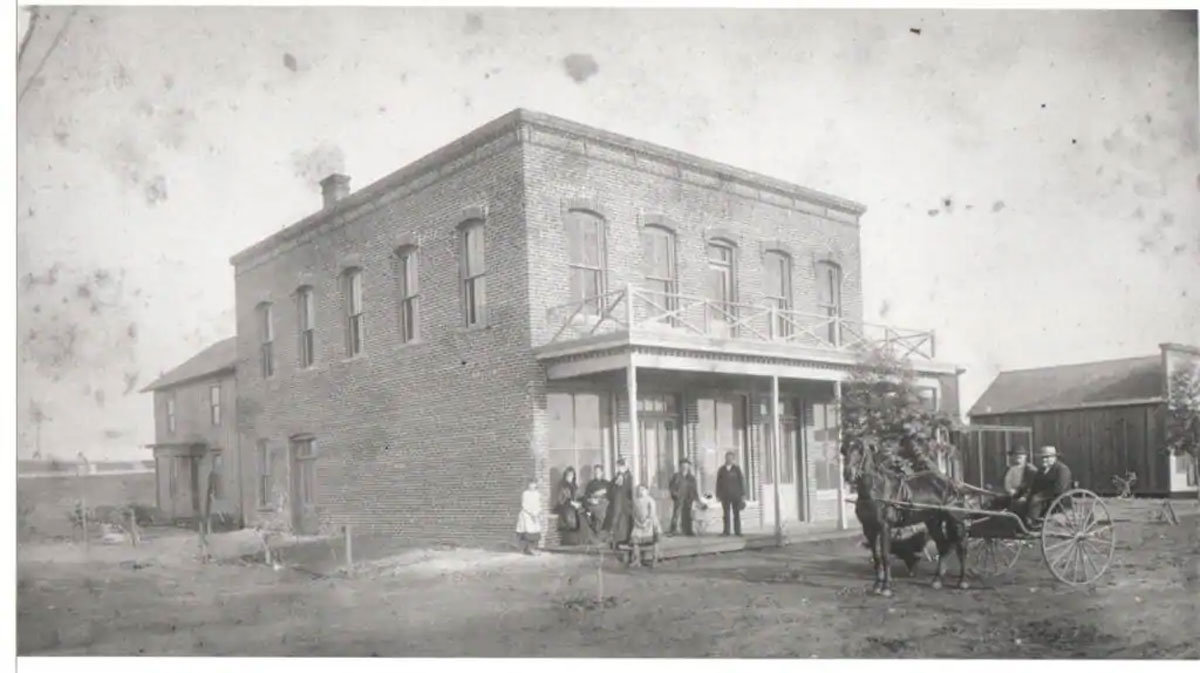
The Bunker House (1886) began as a boarding house and residence, became the Travelers hotel, and is currently standing today, and includes the Apotheque Lifestyle Spa and The Bunker House Cafe & Social Lounge. 322 N Cleveland Street
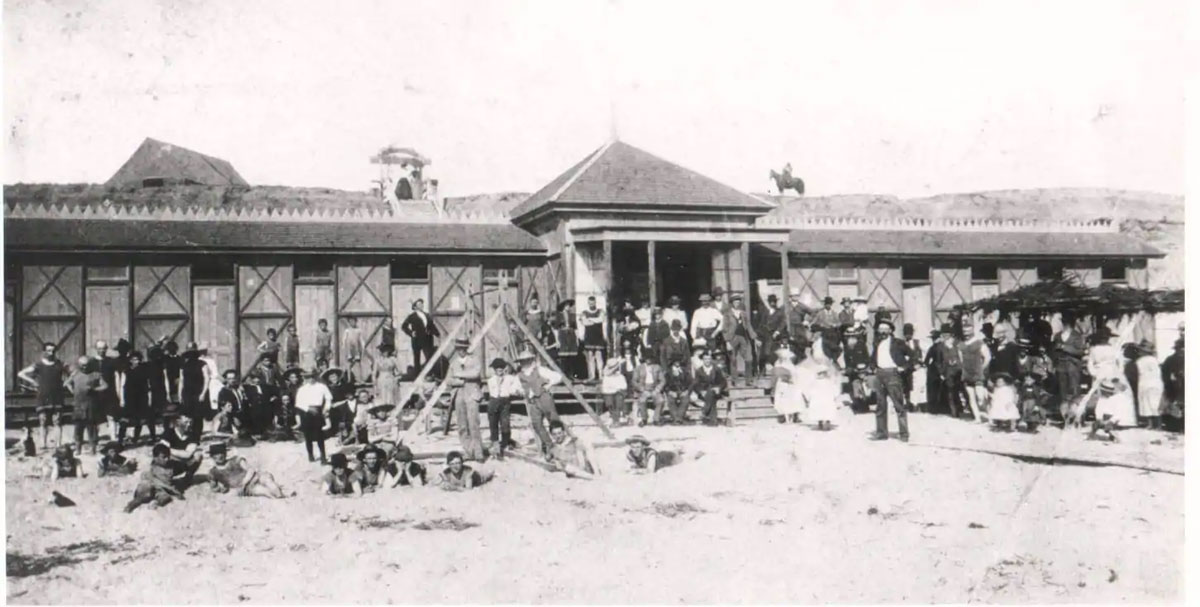
Bath House built by Andrew Jackson Myers in 1885. Torn down in 1904 and replaced by the Oceanside Plunge and powerhouse where the Beach Recreation Center stands today.
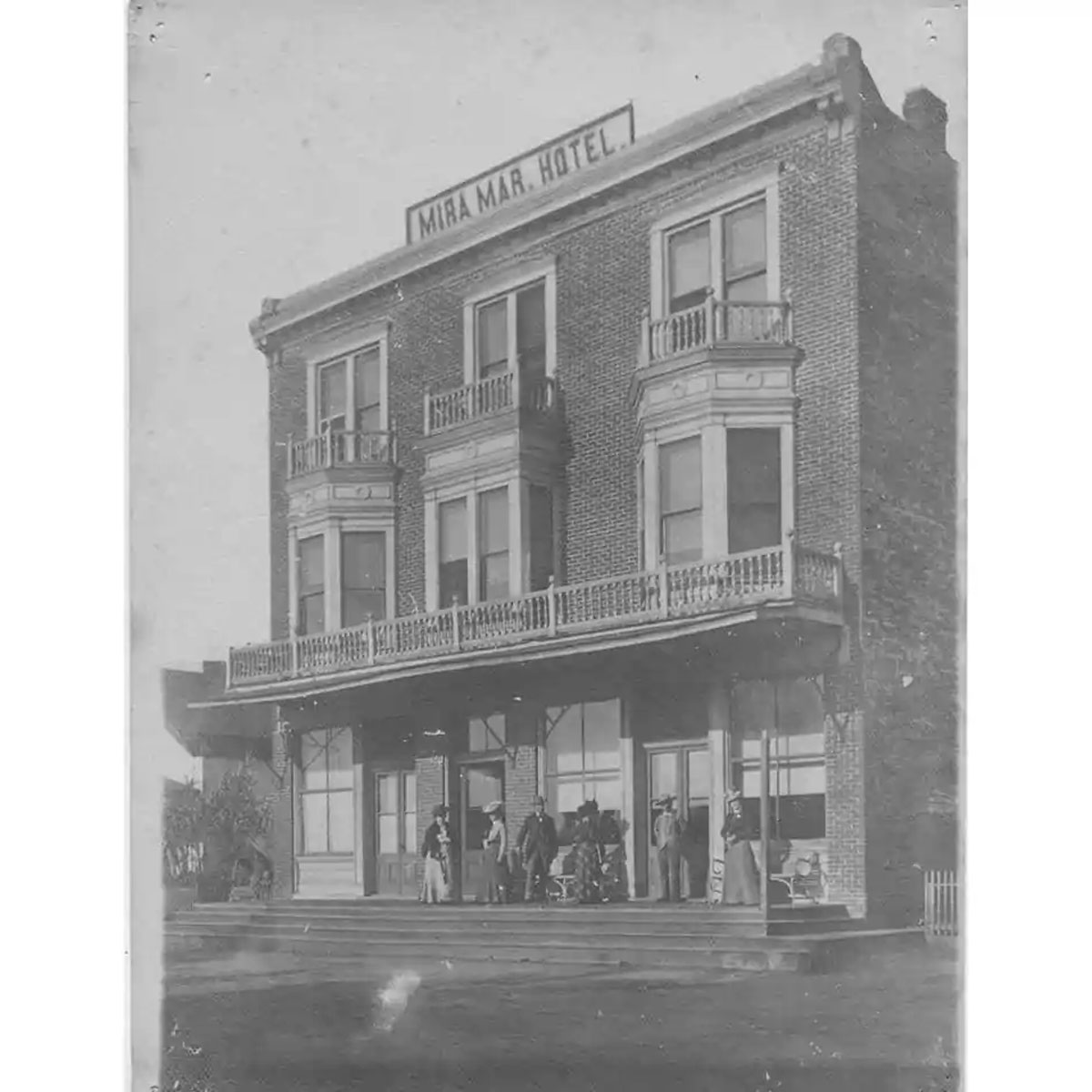
MiraMar Hotel (c1896) originally the St. Cloud Hotel opened in 1885. The building was located on Cleveland, near Pier View and remained a hotel until it was demolished in 1966 as the Seaside Hotel.
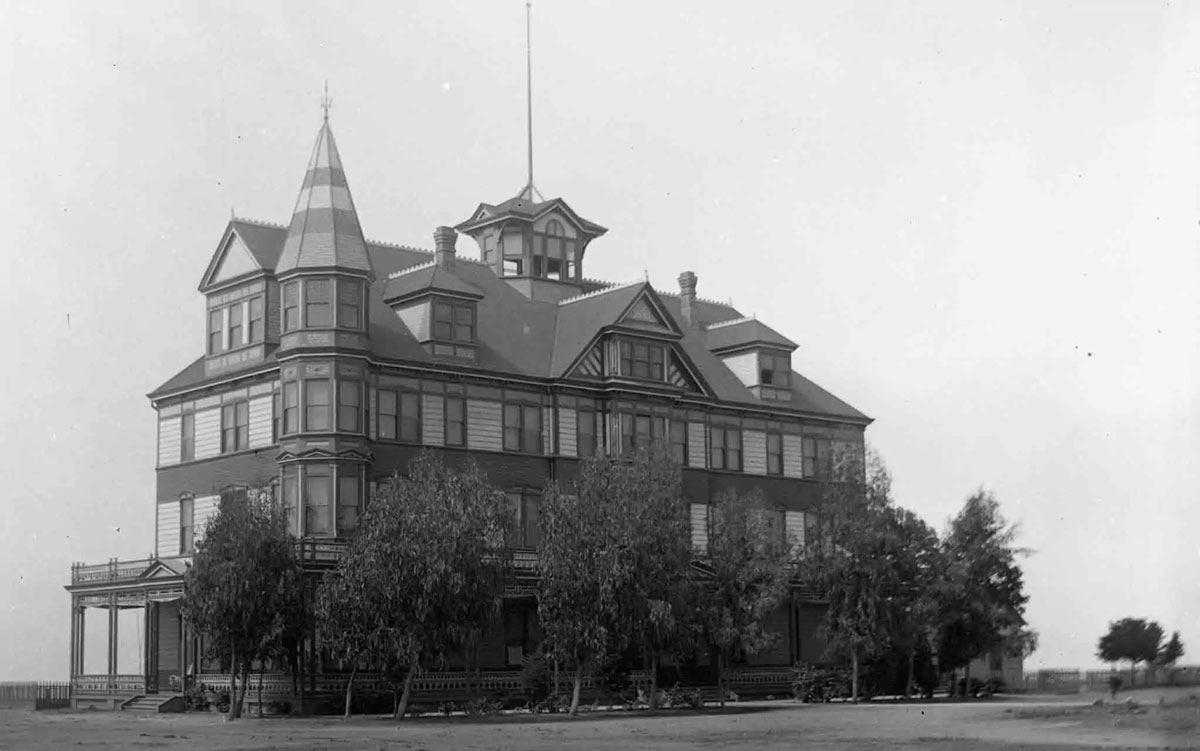
South Pacific Hotel on Pacific Street and Pier View Way. This grand wooden structure was built in 1887, but was unfortunately destroyed by fire in 1896.
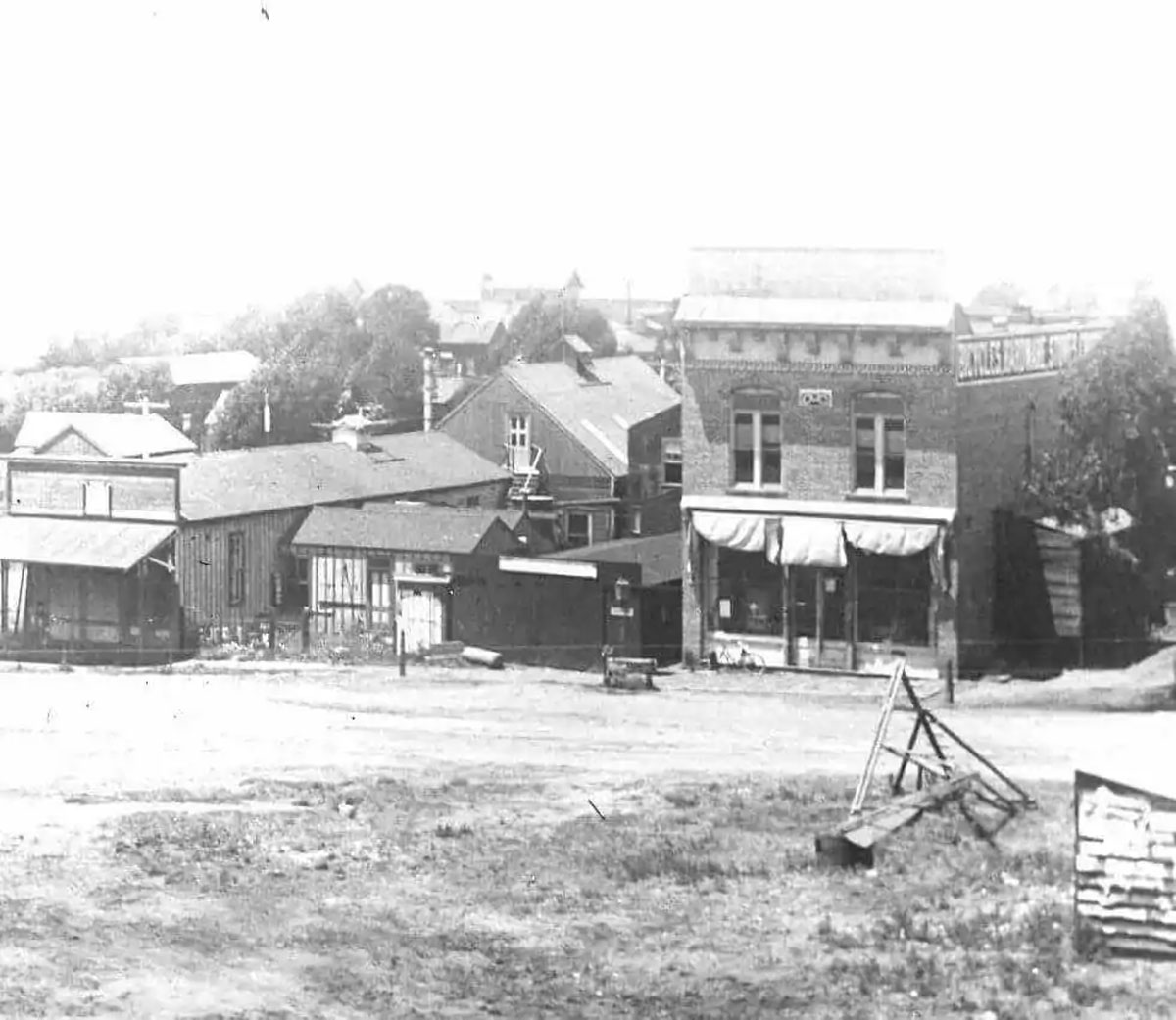
The Schuyler Building (1888) began as a hardware store, became a hotel, then a dry cleaners, and is now home to The Brick Hotel and a cocktail lounge called Frankie’s on 408 Pier View Way.
Oceanside’s wide beaches provided ample room for recreation and camping. The Oceanside Blade claimed that at low tide that one could drive for 10 miles along the beach. Residents and visitors set up tents and canopies for the summer months creating a “tent city.” During hot weather, especially inland, the demand for furnished cottages and beach tents was high. Inland residents would telegraph ahead to reserve a spot on the beach.
In 1902 Captain Sledge plowed up ground south of the depot to plant carnations. Carnations were so common in Oceanside that it became known as “Carnation City”. Franz Hosp, who planted the eucalyptus grove in Carlsbad was the city gardener and was in charge of maintaining the plots of flowers. Carnations as well as geraniums were planted around town on vacant land and on private lawns.
In 1904 a new hotel, the El San Luis Rey, was built and the wooden bathhouse was replaced with a plunge which elevated Oceanside’s resort city status. An early advertisement humorously worded read, “Among other attractions at the hotel are tennis, golf, fishing, hot salt plunge and the safest surf bathing in the world. A paradise for people with overworked brains or nerves. A quiet resort without being stupid.”
In 1914 the Oceanside Tent City Company was formed by J.L. Mathews and others. Fred Hayes was the manager and Charles Rieke the superintendent of construction. The location of the site was north of the plunge. Tent City was touted as a “great advantage to the growth and development of Oceanside.” A description of Tent City amenities: The tents are 12×16 with 6 foot walls and 11 foot ridge. They are made of 10 oz. duck with tan colored fly and are fitted with sanitary couches, two burner blue flame stoves being in each tent. Chairs, chins, cutlery and cooking utensils are provided in plenty and the entire city is electric lighted and piped with water.
The following year there was a greater demand for the tent cottages and builder Charles Rieke began building several “tent and palm houses.” These structures could accommodate 2 to 6 people and could be enlarged with a cook tent. The Blade Tribune reported that “advertising for the summer is already under way and is in the form of literature and slides for showing in moving picture theaters.” The slides included scenes of the beach and Tent City and were sent to Riverside, San Bernardino, Redlands and even Arizona.
The Oceanside Chamber beckoned visitors and new home seekers – “If you long for a beautiful country, with a matchless climate, come to Oceanside, where life is worth living.”
In 1922 George Chell purchased Tent City and in 1925 changed the name to Cottage City. They in turn built more substantial cottages and added a laundry and a social hall. The new cottages contained 2 rooms and a kitchen and also provided garages. Cottage City was located on the North Strand just south of Sixth (now Surfrider).
In 1928 A.J. Clark built 24 cottages on the 700 block of North Strand. They were designed by the Whiting-Mead Company and built at a cost of $25,000. In 1941, Harry and Virginia Roberts acquired the cottages who gave them their present name. The iconic double row of (mostly) pink houses continues to be a favorite vacation spot.
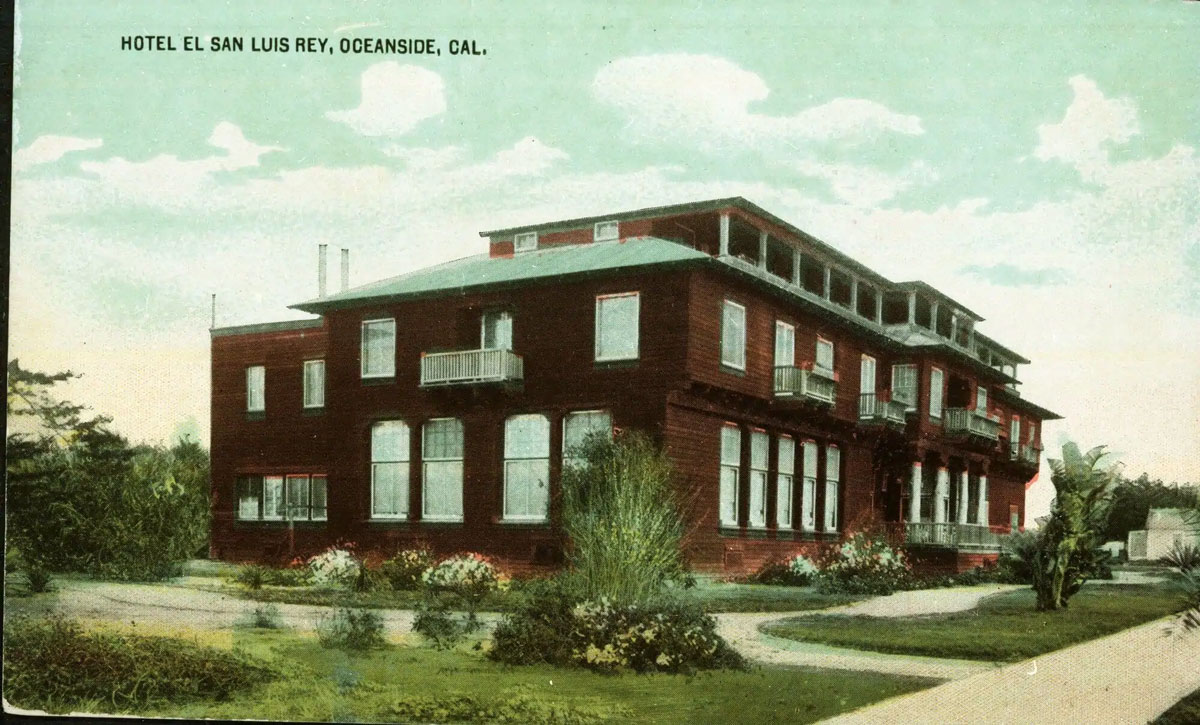
The Hotel El San Luis Rey was built on Pacific Street in 1904. It became the Beach Hotel and then finally was the Colonial Inn when it was torn down after to falling into disrepair in 1966.
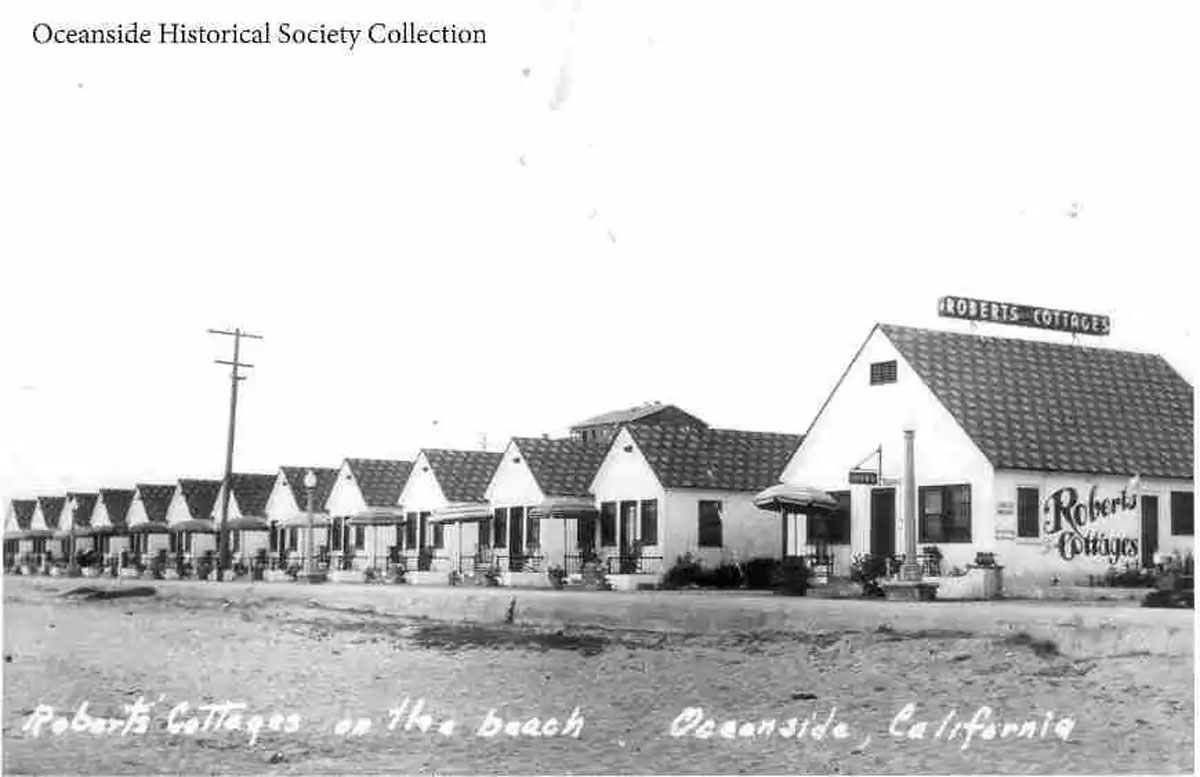
Robert’s Cottages built in 1928 remain a popular getaway stay today. 704 The Strand North.
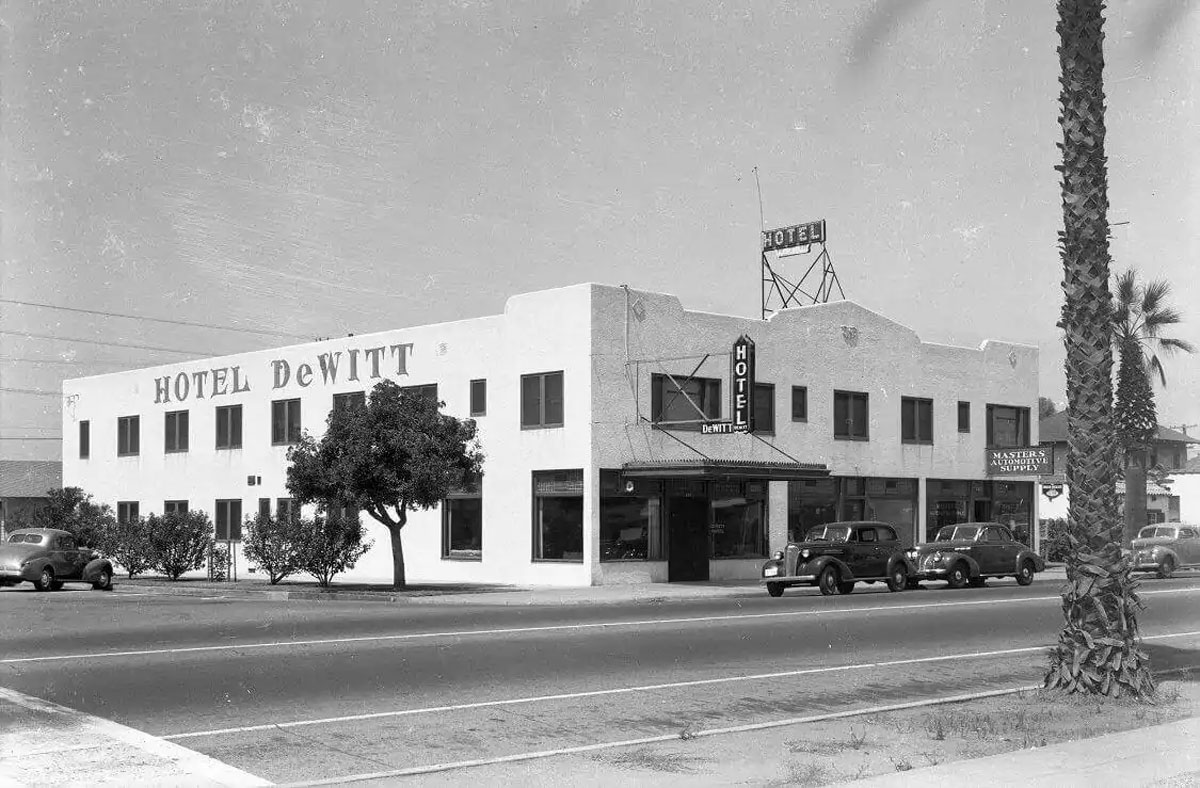
Hotel DeWitt c.1945. Opened in 1927 as the Keisker Hotel. Reopened as The Fin Hotel in 2018 after an extensive renovation.
Continuing efforts to attract and satisfy visitors, Oceanside was concerned about appearances. Every spring there were spearheaded efforts to maintain the beach by trimming shrubbery, mowing the lawns in the park and planting geraniums on the bluff that could be seen from the pier.
Fishing, always a favorite pastime – even before Oceanside existed – was made more appealing with fishing barges for deep sea fishing. Whether fishing from the surf, pier or barge, the newspaper routinely reported weekly catches of barracuda, smelt, mackerel, herring, yellow fin, croakers, sharks and black sea bass. Catching giant black sea bass was a common occurrence and many were upwards of 200 pounds or more.
Another attraction putting Oceanside on the map was its homegrown beauty. Beauty contests began in the early 1920s and soon Oceanside became the home of the Miss Southern California Beauty Contest. In early years the contestants were sponsored by merchants from all over Southern California and the girls wore sashes advertising their sponsors. The Oceanside band shell was covered in greenery, palms and gladiolas and a runway was added. Thousands of spectators would arrive from all over to view the event and watching the crowning. In 1956 Raquel Tejada aka Raquel Welch came in second place, as the judges seemed to favor leggy blondes.
In 1930 concessions were added to the pier area which included a miniature nine hole golf course. Al Thill built a lunch counter and refreshment stand and a merry-go-round was added. Dancing at the pier pavilion and beach concerts were all favorite attractions. The Blade noted, “It looks like a big year at the beach.”
The beach, the historic Mission San Luis Rey, the beautiful weather, the Pacific Ocean and other amenities continue to attract tourists and visitors and help to make Oceanside where life is worth living!
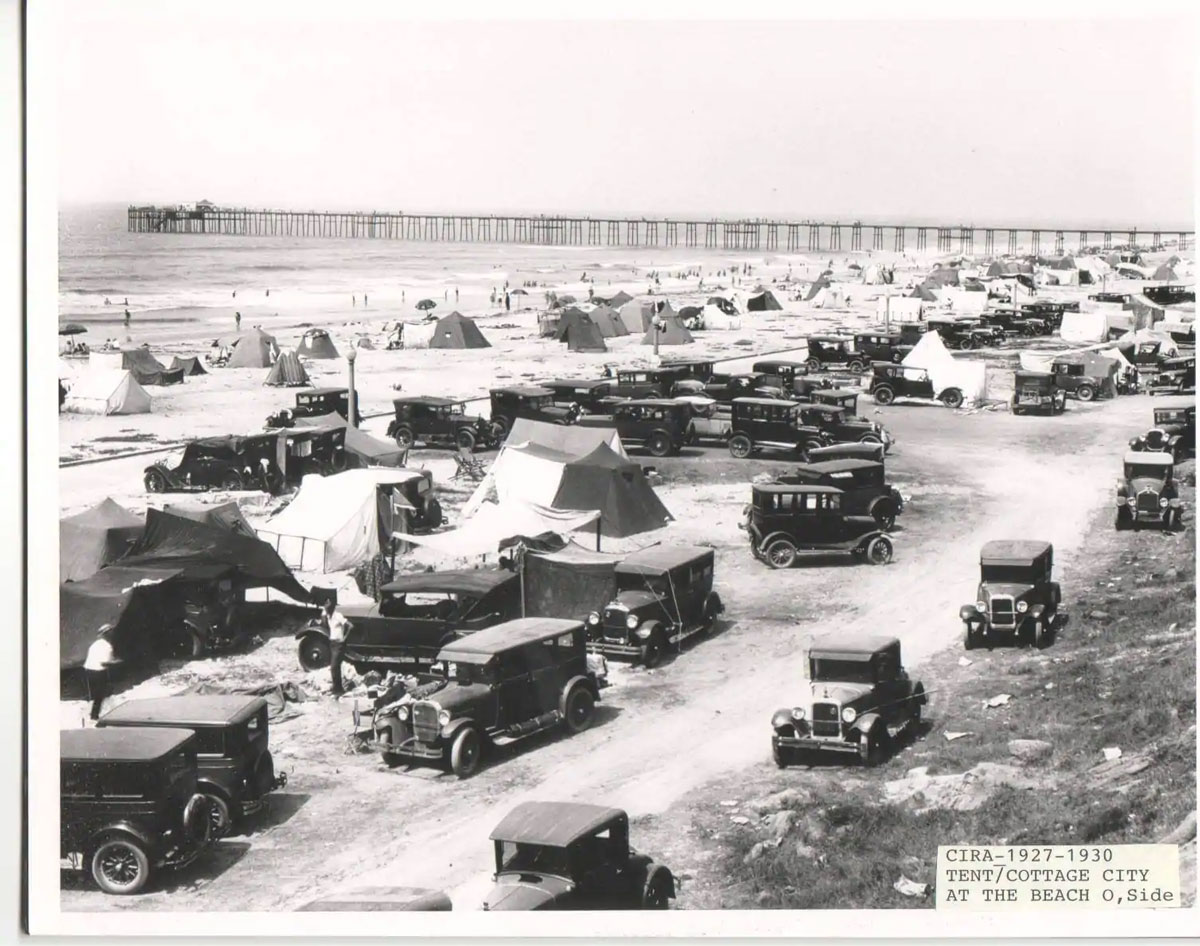
Tent City was touted as a “great advantage to the growth and development of Oceanside.”
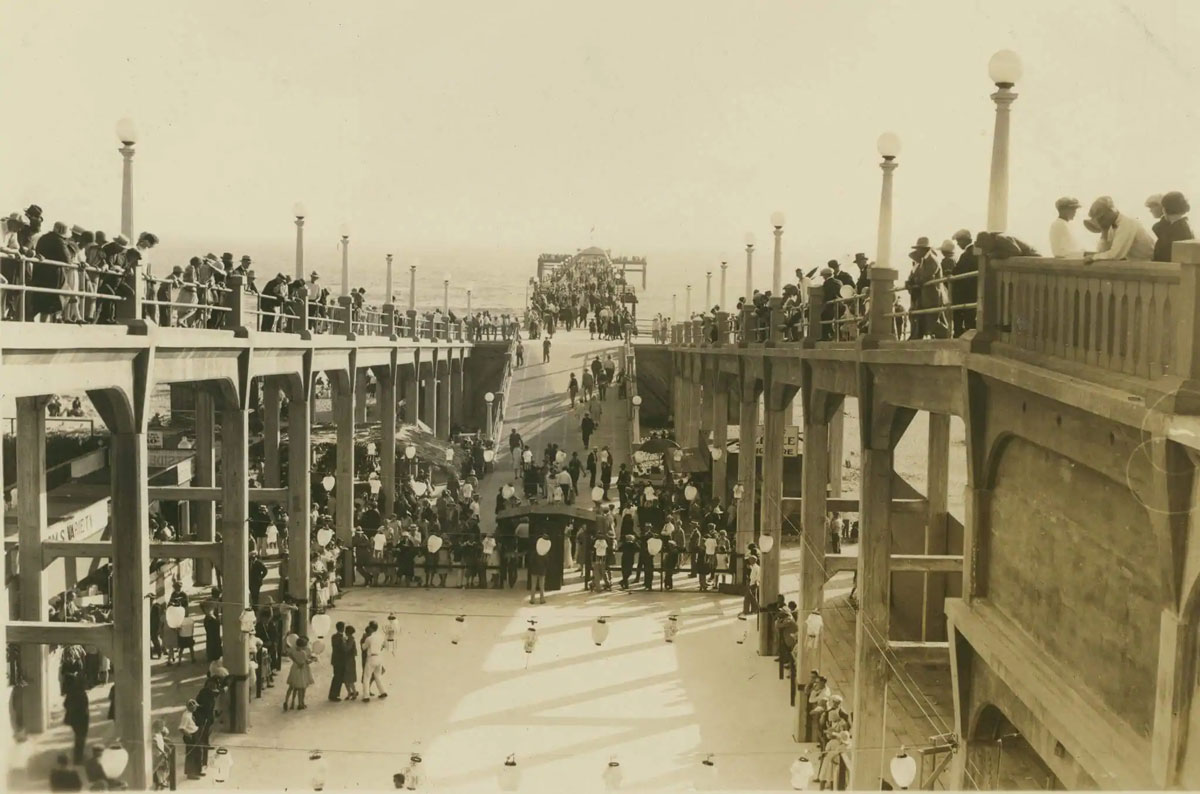
Dancing in the Oceanside Pier Plaza (c1930)
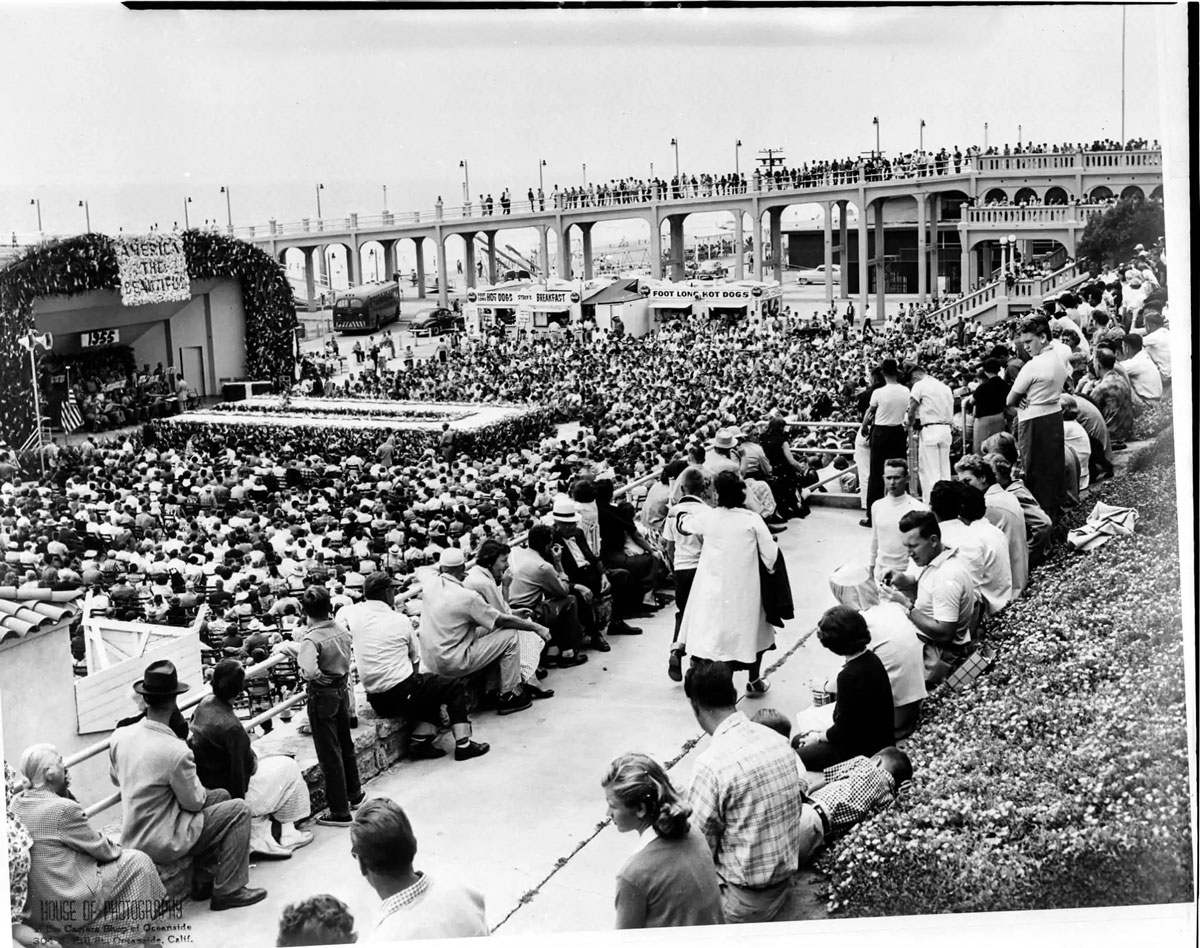
Beauty contests began in the early 1920s and soon Oceanside became the home of the Miss Southern California Beauty Contest.
St. Malo Summer Cottages
A group of twelve homes was built by 1934 in an exclusive enclave in South Oceanside at the end of Pacific Street. Pasadena resident Kenyon A. Keith purchased 28 acres of oceanfront property and contained homes resembling a French fishing village that was known as St. Malo. Well-to-do property owners used St. Malo for vacation and summer homes. Early film director Jason S. Joy’s home was identified as “La Garde Joyeuse” and included an outdoor bowling alley and volleyball court. Author Ben Hecht was another resident, as well as Frank Butler, who co-wrote “Going My Way”. The beautiful community of St. Malo remains one of Oceanside’s best kept secrets and continues to serve as summer homes and getaways for the rich and famous.
Fun fact: During the 1984 Los Angeles Olympics, Prince Phillip and Princess Anne stayed in St. Malo, Oceanside’s exclusive community.
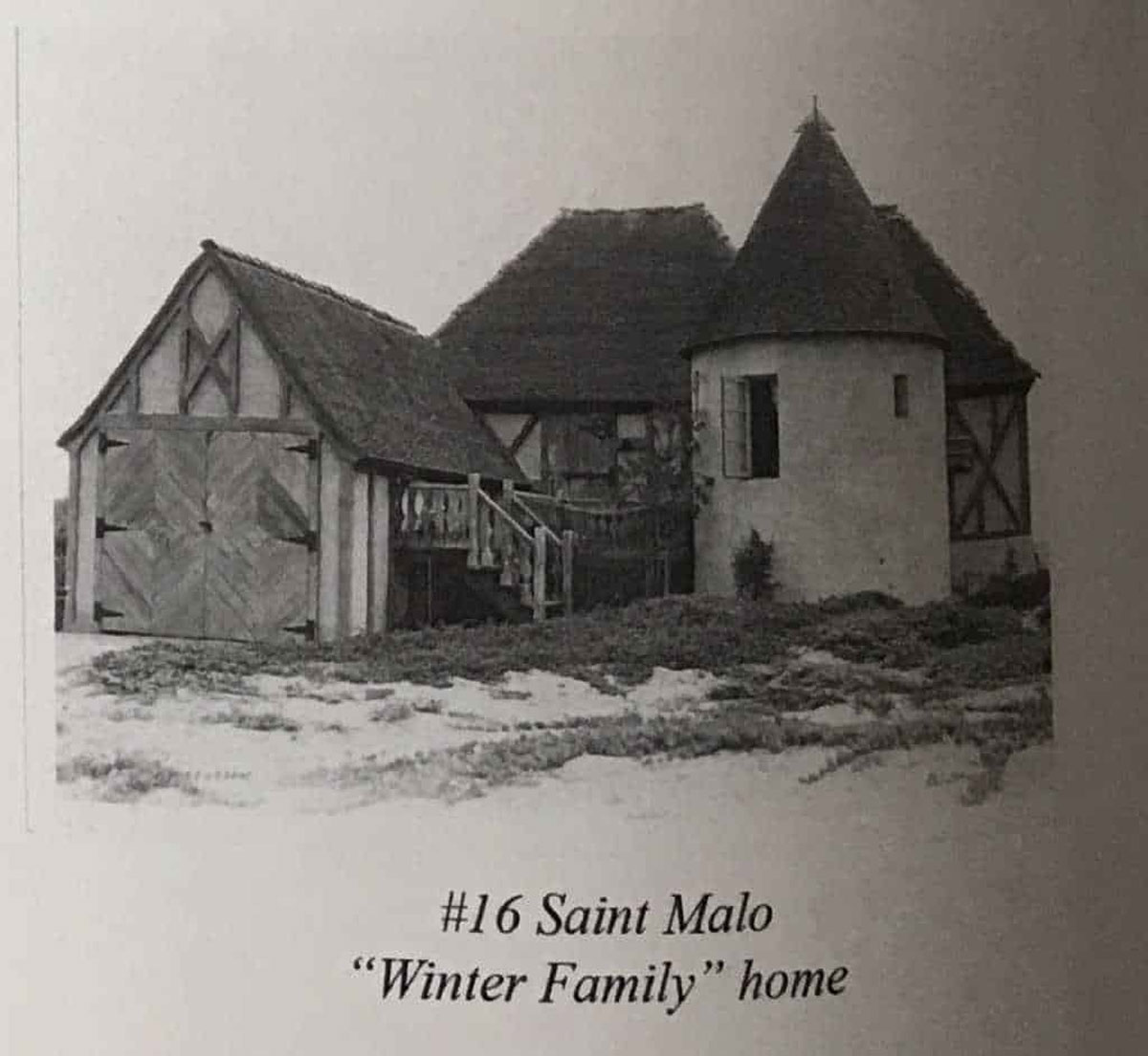
Courtesy of “The History of St. Malo” by Nancy Keith Tenaglia
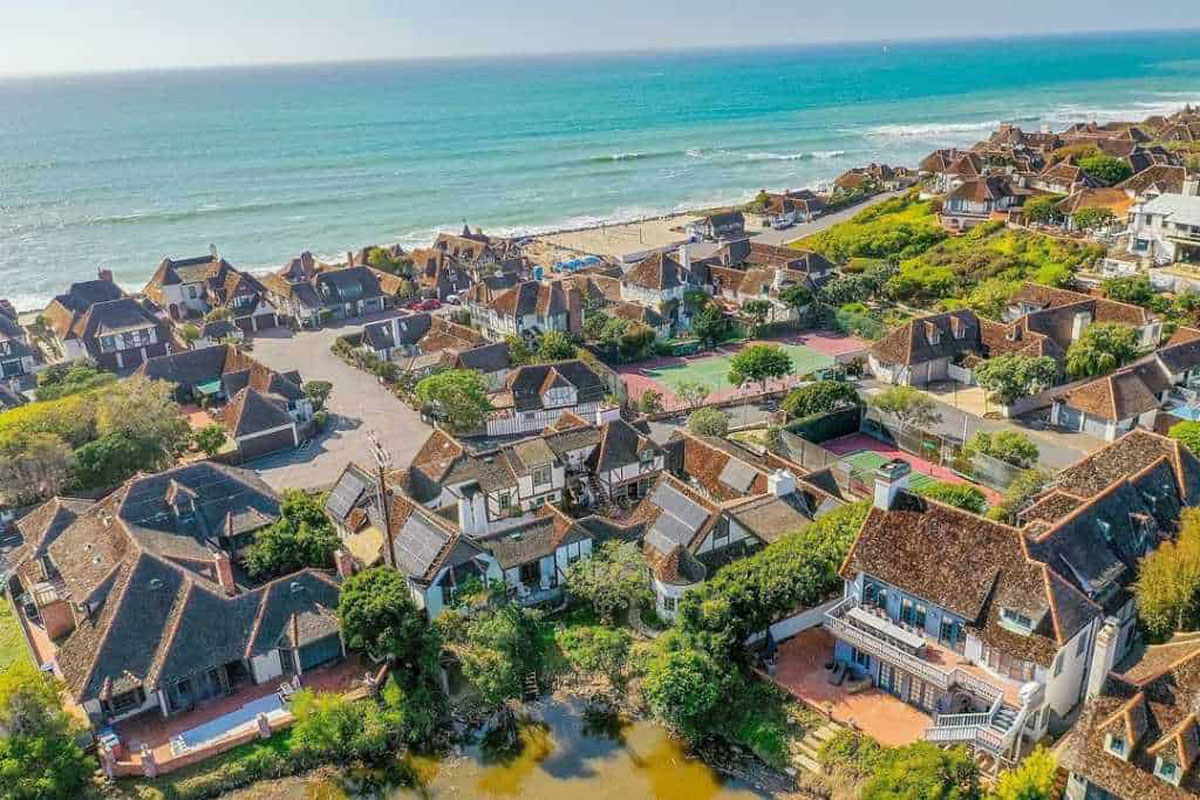
St Malo 2021, Photo by: @aerial9media
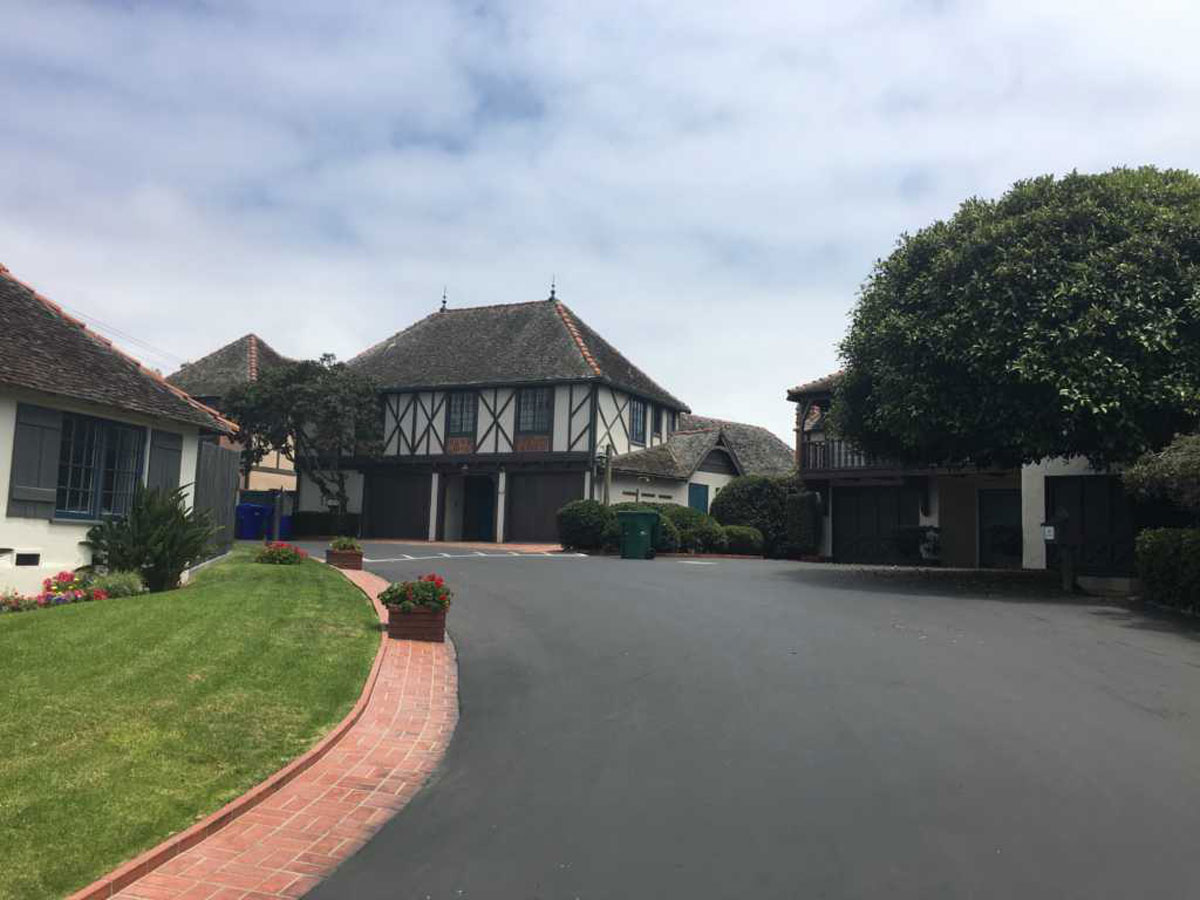
St. Malo Today, Photo by: Kristi Hawthorne
The Motor Inn and Motel Room
In the early 1900’s automobiles become the preferred way to travel for many families due to its affordability and convenience. Since many hotels were in downtown locations with limited parking, a need arose for roadside inns where patrons could quickly and easily pull up and park. The first generation of these in the 1930’s and 1940’s were known as cottage courts or traveler’s courts. Oceanside responded with lodging like Robert’s Cottages, Surf-Side Cottage, and the Traveler’s Auto Court.
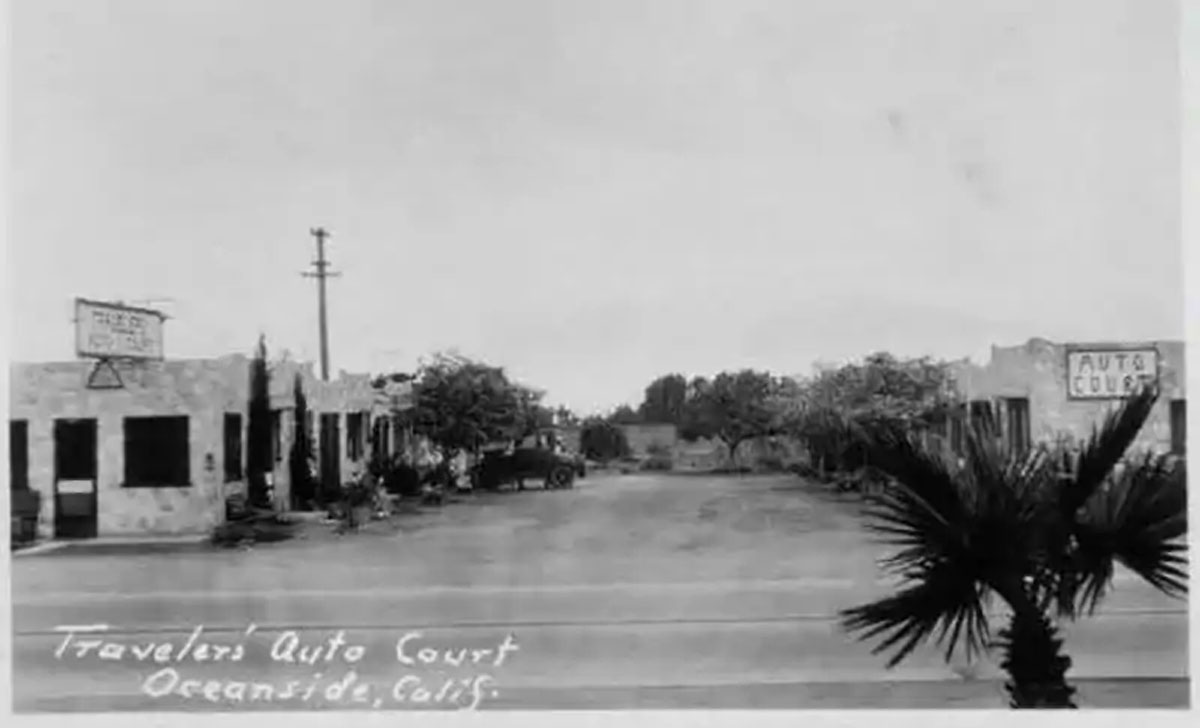
Travelers Auto Court (1930) became Wally Johnson Motel and remains the Coast Inn today.
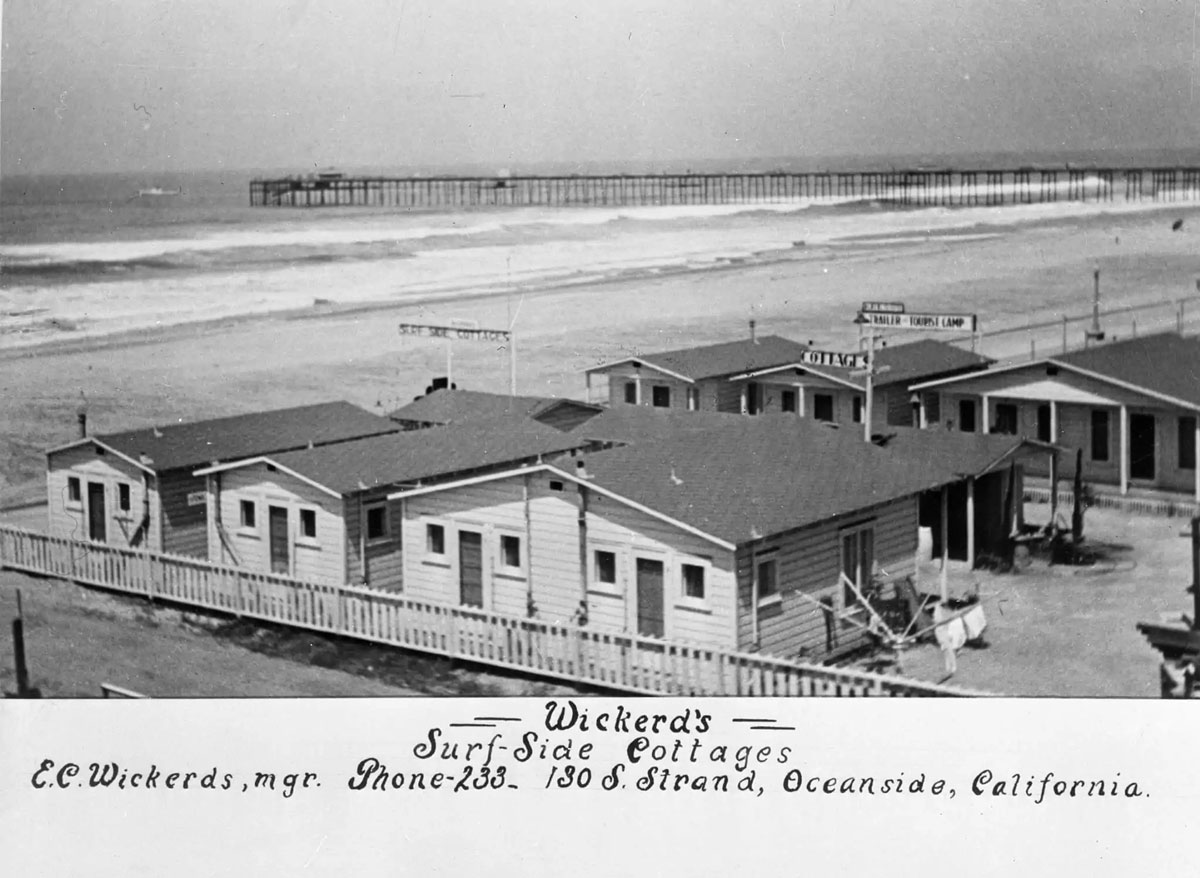
Wickerd’s Surf-Side Cottages (c1938) 130 South Strand.
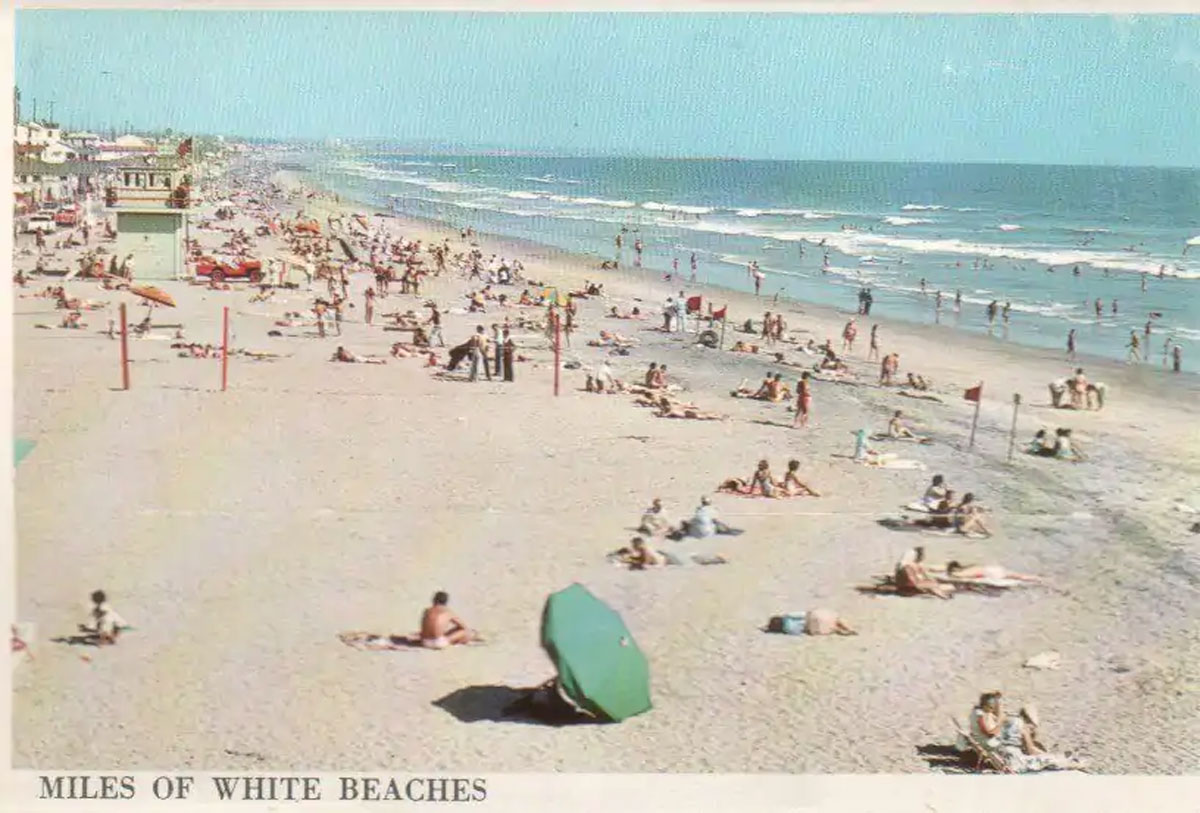
Idealistic white sand beaches had tourists flocking to Oceanside in the 1950s.
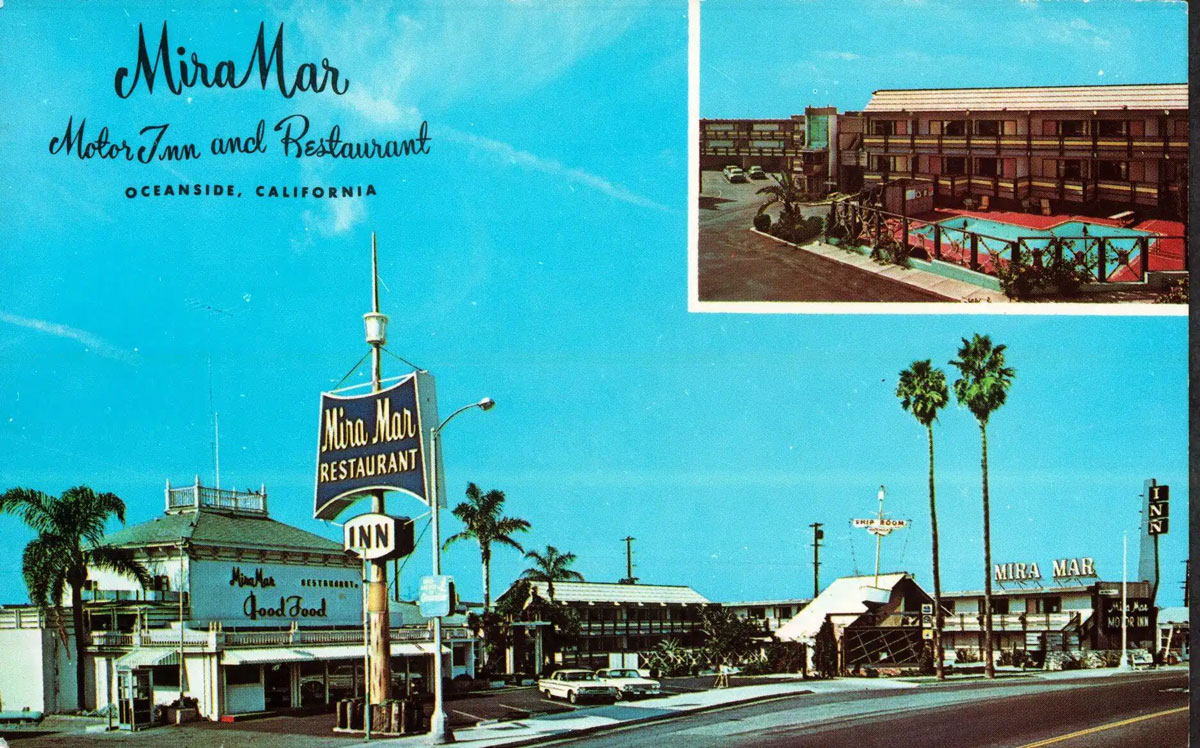
The Mira Mar Motor in opened in 1959. Currently the Motel 6 on the corner of Coast Highway and 76.
As tourism began to grow in Oceanside in the 50s and 60s, more fully integrated hotels began popping up, or “motels,” a name coined by the owner of the Milestone Mo-Tel (an abbreviation of “motor hotel”) in San Luis Obispo, California. Most of these larger motels structures built during this time period still exist in Oceanside today.
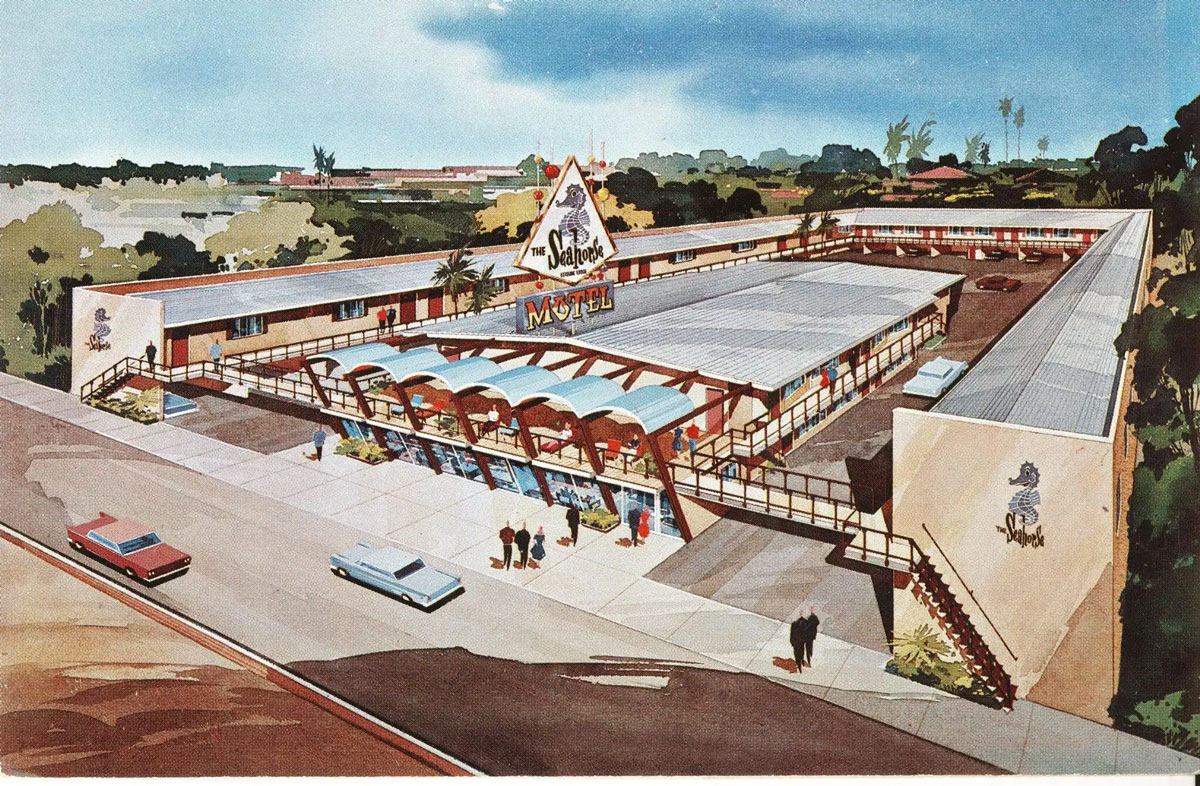
The Seahorse Leisure Lodge c1950 was located at 622 N. The Strand and was demolished in 1966.
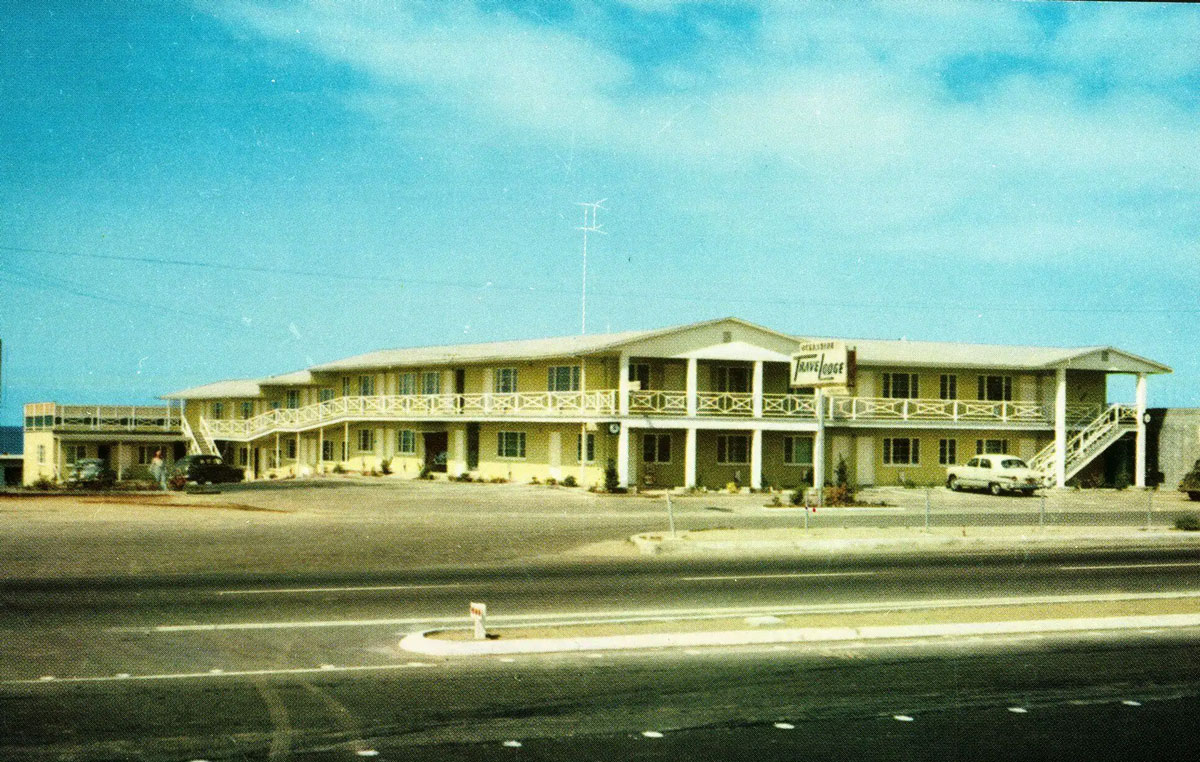
Oceanside Travelodge c1960 currently the Harbor Inn & Suites on North Coast Highway
In 1973 the Jolly Roger Restaurant opened on North Harbor Drive and on October 3, 1984 Monterey Bay Canners opened its doors. One of the longest running restaurants is that of Harbor Fish and Chips. Owner Terry Cross was born and raised in Oceanside and this family owned and operated business has been a mainstay at the Harbor for over fifty years and continues to be a favorite of locals.
The Oceanside Harbor was the home port of the United States Coast Guard Point Hobart from 1969 to 1999. Its primary purpose was to provide additional security for President Nixon when he visited the ‘Western White House’ near San Mateo Point. The Point Hobart also provided search and rescue services.
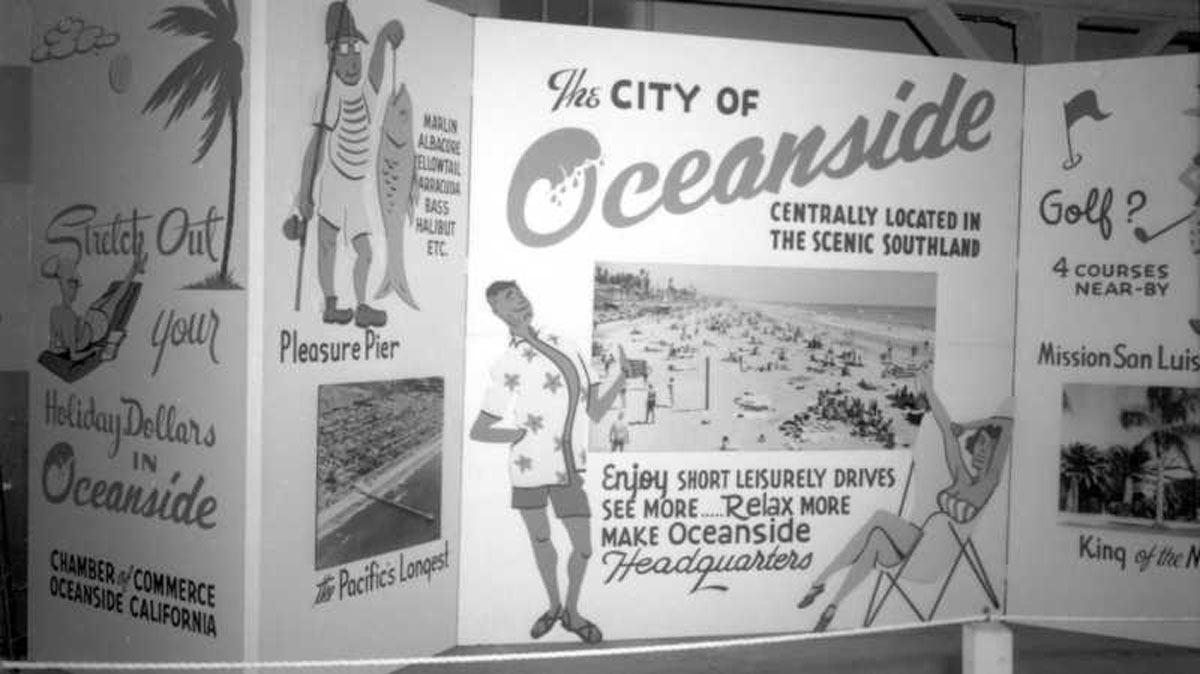
Vintage Oceanside Advertisement – City’s 75th Anniversary
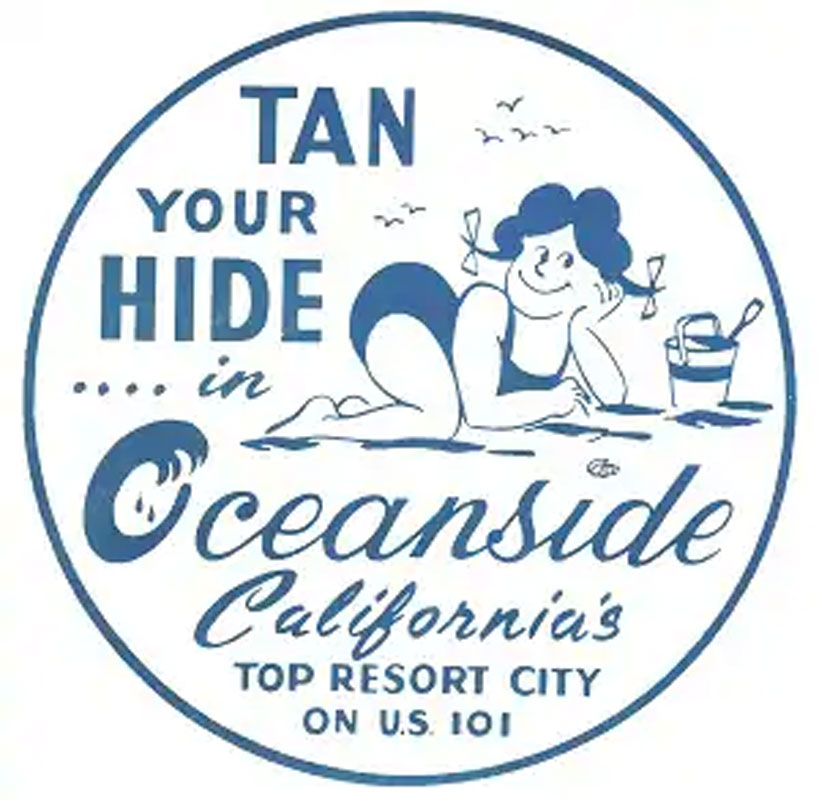
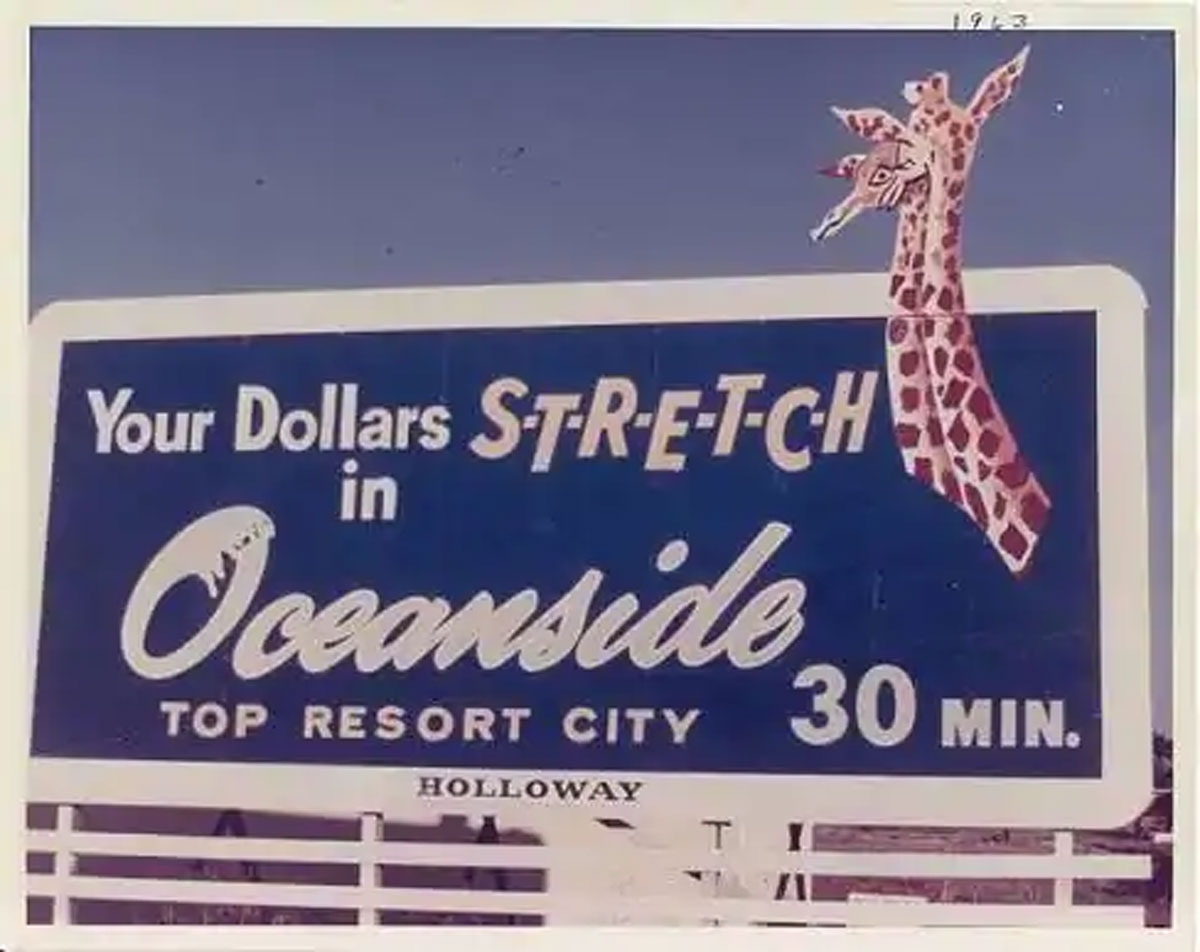
Oceanside Top Resort City Sign 1963
Early Tourism Marketing
Oceanside Tourism Slogans and City Mottos
The Past Meets the Future
Experience Oceanside’s historical vibrancy when you visit the city and make some thrilling vacation memories for yourself. Even Oceanside’s earliest visionaries knew going to the “ocean side” was going to remain a popular weekend retreat for families living in warmer climates for generations to come. From its establishment in 1888 to now, O’side continues to be the place that offers a respite for visitors and locals alike.
When you arrive, don’t forget to check out some of the more recently restored historical buildings around town! Built in 1888, the Schuyler Building was originally a two-story unit operating as Schuyler Hardware Store. Now this historical building has been transformed to become a new boutique hotel and restaurant, named The Brick Hotel. Keep an eye out for updates on the grand opening of this new addition to Pier View Way. New cocktail lounge: Frankie’s Oceanside, located adjacent to the hotel, is also part of the project and opened in early 2021.
As one of two new Hyatt Resorts to open this year, The Seabird Resort is a gorgeous new, family-friendly hotel with indulgent amenities, inventive eateries, complete with a pool and spa. Directly north of The Seabird Resort is the Mission Pacific Hotel. The Mission Pacific is now home to the newly renovated Graves House – most well-known for its on-camera appearance in the film Top Gun. Be sure to drive by and see the photo-worthy renovation when you visit!
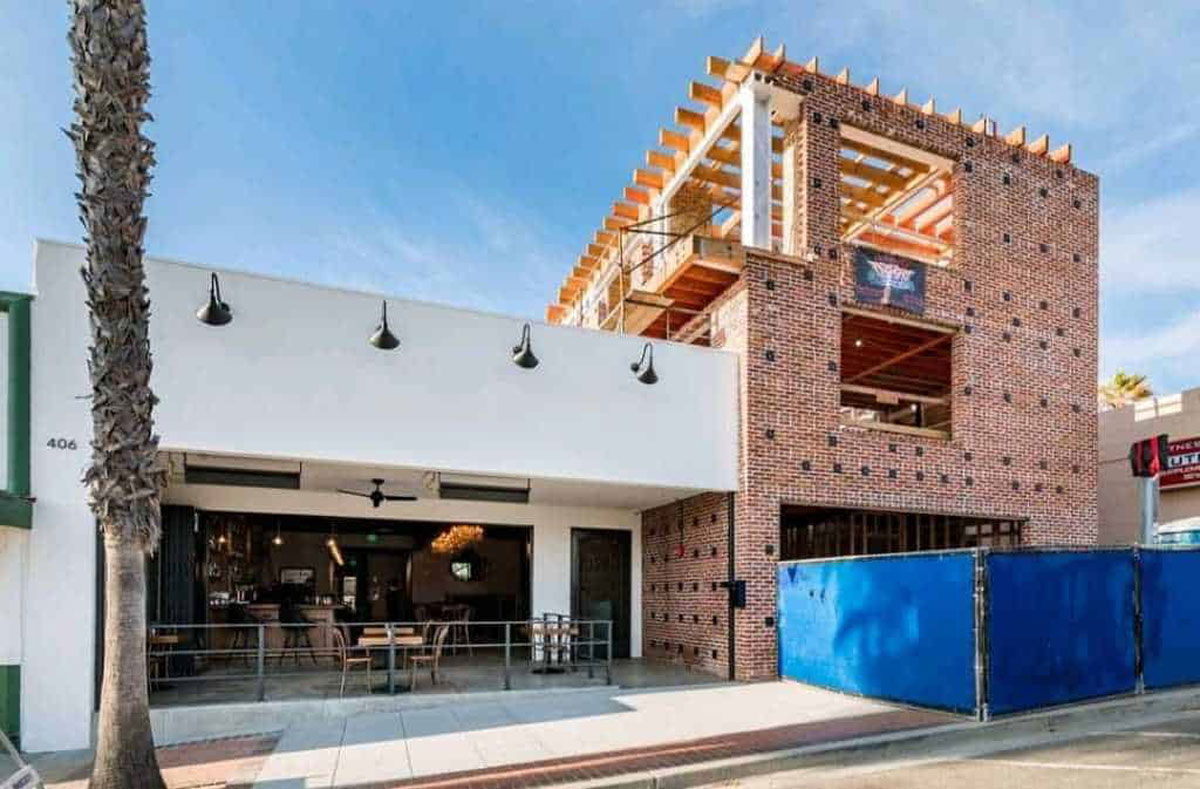
Brick Hotel and Frankies Oceanside 2021
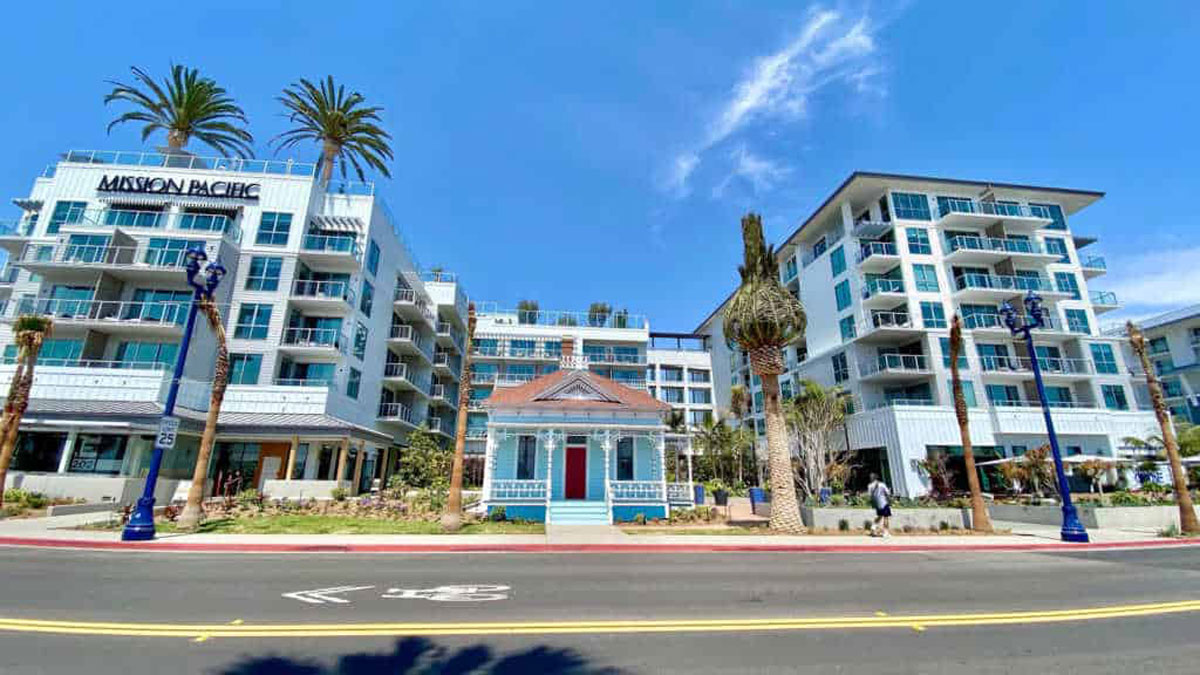
Mission Pacific Hotel Front View
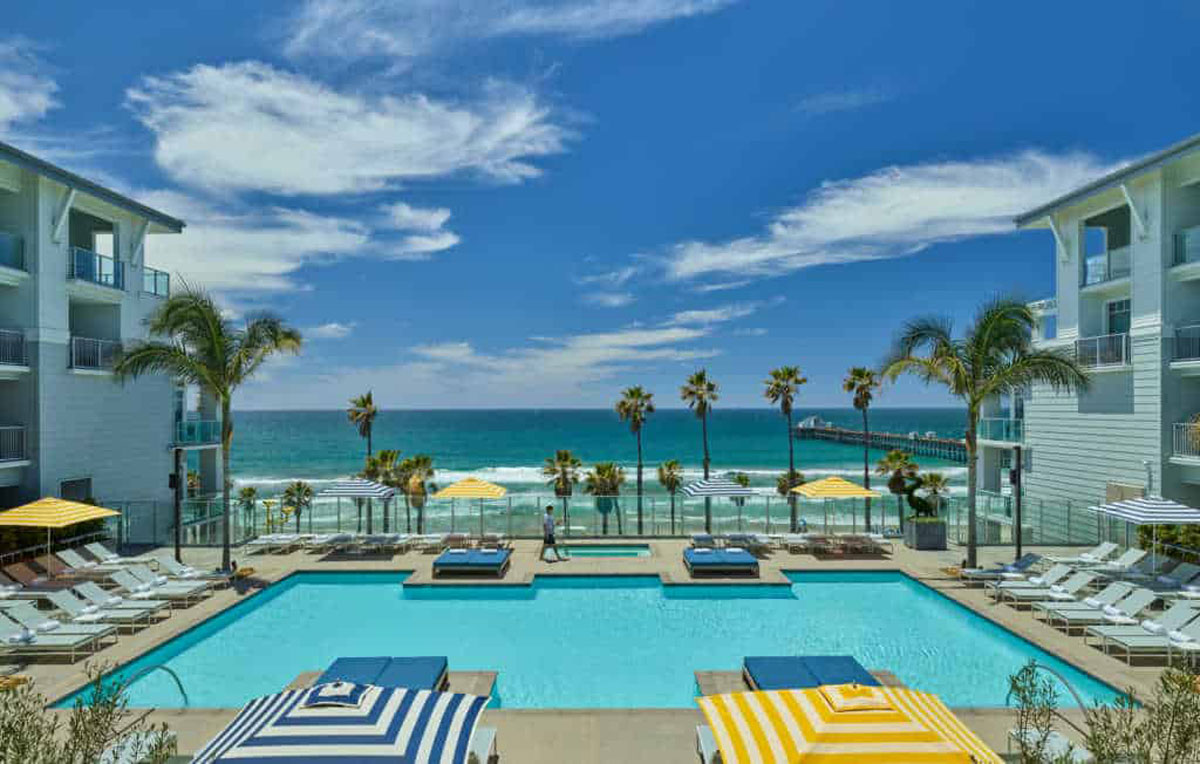
Seabird Resort Pool View
“We are real glad to be able to announce that great need and want of Oceanside – a good hotel – is about to be satisfied. Oceanside has always seemed to us to be one of the finest seaside resorts. We have known Oceanside ever since before there was an Oceanside, when it was simply Jack Myers’ homestead. We like the location, then. We like it still. Therefore we are glad a new, modern hotel is to be built.” – Redlands Citrograph, 1903

Kristi Hawthorne has been a resident of Oceanside since 1983, began volunteering for the Oceanside Historical Society in 1987 and has served on the board of the Oceanside Historical Society for over 30 years and as president since 2002. She conducts Downtown History Walks for the public each year and presents regular historical programs at the Oceanside Public Library. She is known as the “historian” of Oceanside, writing a history book entitled “Oceanside, Where Life is Worth Living.” Kristi has been an avid supporter of Oceanside, proud to live and work in the City which she loves and has raised a family with her husband. Her blog, Histories and Mysteries, provides readers an in-depth look at people, places and events in our City’s history.
Published: January 21, 2022
